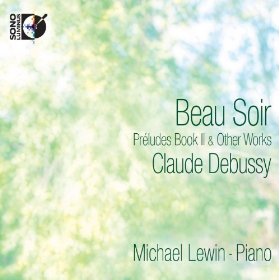– –
The Album
[Rating:4.5/5]
The advent of impressionistic music is generally credited to two French composers, Maurice Ravel and Claude Debussy. Although the latter wrote a number of pieces for orchestra, most of his works were composed for the solo piano. The program of Beau Soir a well-known song arranged for piano, covers a wide range of moods and keyboard effects:
- Beau Soir (arr. Attwood): 3:19
- L’isle joyeuse: 6:02
- Le petit berger: 2:46
- Danse (Tarantelle Styrienne): 5:00
- Elegie: 2:08
- Etude No. V. Pour les octaves: 2:54
- Valse romantique: 3:31
- La plus que lent: 4:31
Preludes: Book II
- Brouillards: 3:11
- Feuille mortes: 2:57
- La Puerta del Vino: 3:06
- Les Fees sont d’exquisites danseuses: 3:02
- Bruyeres: 3:09
- General Lavine-eccentric: 2:48
- La terrasse des audiences du clair de lune: 4:26
- Ondine: 3:19
- Hommage a S. Pickwick, Esq, P.P.M.P.C.: 2:27
- Canope: 3:10
- Les tierces alternees: 2:34
- Feux d’artifice: 4:45
With the exception of the L’isle joyeuse, none of these piano miniatures lasts more than five minutes. Yet, in those fleeting musical moments, Debussy creates a world of unique sound pictures with the keyboard providing the canvas and the notes, the paint.
Many of these piano pieces place considerable technical demands on the soloist, such as the massive tonal palette of L’isle joyeuse or the broad dynamic contrasts of Feux d’artifice. Others like the Danse, La Puerta del Vino or Valse Romantique must keep the dance rhythms in the foreground. Still others have a dreamlike quality as in Feuilles mortes or the gamelan-inflected Bruyeres. To succeed in such a program, spanning the entire gamut of Debussy’s career, a pianist must have more than just manual dexterity. He or she must have an innate sense of how the rhythms and the colors of each piece work synergistically to create a final impression for the listener.
We are most fortunate, in this case, to have piano virtuoso Michael Lewin at the keyboards. Mr. Lewin, a Julliard graduate (and Leon Fleischer protégé) is a prize-winning artist who has never shied away from challenging repertoire that ranges from Franz Liszt to Charles Tomlinson Griffes. As listeners will quickly gather, this recital shows off Lewin’s ability to dig deeply into each of these small masterpieces and extract what the composer intended without letting his style trump their meaning.
Audio Quality
[Rating:4.5/5]
The Steinway Model D Concert Grand, the company’s flagship piano, used in this recording has been manufactured continuously for more than a century. It is a huge instrument capable of equally huge sounds, making it the go-to piano for many of the world’s top artists. Capturing the essence of this piano (having grown up with one I know what it sounds like in person) has always been an audio engineer’s dream and challenge. The Pure Audio 5.1 DTS-HD Master Audio version that I auditioned (a 2.0 and a 7.1 DTS-HD Master Audio version, the latter at a lower sampling rate are also included) was simply stunning. Tonal balance was faithfully captured and the piano’s image was incredibly life-like and three-dimensional.
Supplemental Materials
[Rating:4/5]
Sono Luminus provides a bonus standard CD of this program and very detailed liner notes by the artist. There is a brief biography of Mr. Lewin.
The Definitive Word
Overall:
[Rating:4.5/5]
This is a very well chosen program with considerable variety in its moods and tempi. As such, the performance values of Beau Soir are quite competitive with the best out there including recordings by such keyboard luminaries as Walter Gieseking, Arturo Benedettti Michelangeli, and, more recently, Jean-Yves Thibaudet. Michael Lewin’s disc gains considerable advantage over its predecessors with fabulous sonics that simply let more of Debussy’s tonal palette reach my ears. Another Sono Luminus winner!


